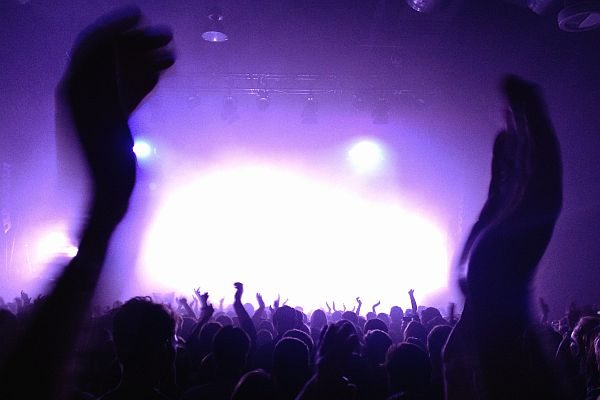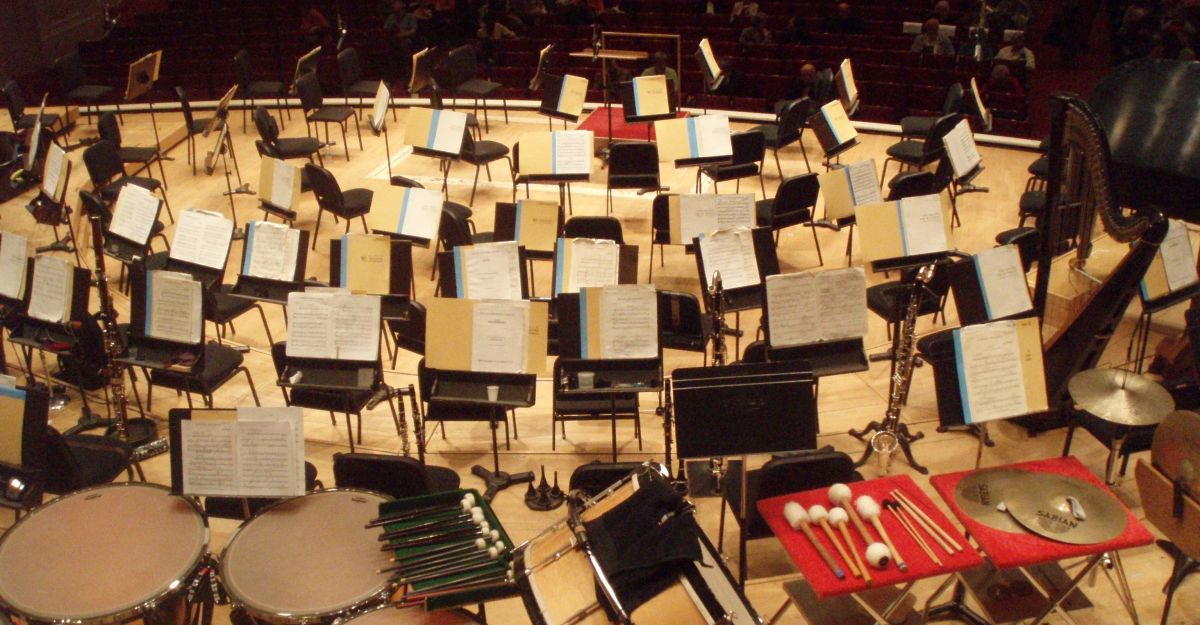Four men in red and leather address a crowd of thousands, their arms outstretched like inverted peace signs. Disembodied, we float over the assembly of workers wearing white boilersuits as they stand in unison, mirroring the gesture of the men on stage. Closing in on the ringleaders, we catch a glimpse of someone’s hands among the crowd, poised and ready for union. Then all we hear is, ‘Radio Ga Ga!’ – clap-clap – and we can’t help but join in.
Clapping is a catchy human impulse. Some babies pick it up when they’re as young as six months old. As a custom, applause may be as ancient and pervasive as humanity itself. So, unsurprisingly, clapping is fundamental to many musical genres, such as the ‘palmas’ Flamenco style in Spain, the ‘keplok’ clapping of Javanese gamelan, and the Arabic folk art of ‘kaff’.
Compared to these intricate beats, the standard 4/4 rhythm of western pop music is relatively simple (if you’ve ever seen an Anglo uncle dance at a wedding, you’ll know why). Hand-claps in pop and rock songs are similarly humble, typically accentuating or replacing the snare drum on the second and fourth beats. This reliability – even predictability – means it’s all the more exciting when a flashy frontperson or intrepid producer goes rogue …
‘All we hear is, ‘Radio Ga Ga!’’ Clap-clap.
‘Hey, Dirty. Baby, I got your money,’ clap-clap.
‘Golden years, gooold, whop, whop, whop,’ [one, two, three] clap-clap.
The ultimate pop music power move, a double clap is the aural equivalent of using two exclamation points back-to-back!! It can be called upon to open a song (‘Shake Appeal’ by serial offenders The Stooges); ramp up a big finale (Meat Loaf’s ‘You Took the Words Right Out of My Mouth’); or bookend a tune with a sonic signifier of camaraderie (The Cars’ ‘My Best Friend’s Girl’). In every case, it’s an auditory call-to-arms that rallies concert goers and loungeroom groovers to clap along if, to paraphrase Pharrell, that’s what they want to do.
Hand claps are essential to gospel rhythms and, thus, single claps can be heard backing the drums on seminal 1950s rock ‘n’ roll songs like Big Mama Thornton’s ‘Hound Dog’ and Joe Turner’s ‘Shake, Rattle and Roll’. At the same time, Bo Diddley started flexing the syncopated clap, a-clap, a-clap, a-clap-clap rhythm with which his name would become synonymous. Although his self-titled debut single featured neither single nor double claps, its Afro-Cuban beat set the pace for entertainers like Eddie Cochran, whose 1958 single ‘Summertime Blues’ was an early proponent of the double clap in mainstream pop.
In the 1960s, girl groups and solo starlets began using double claps to evoke the schoolyard sassiness that bubbles in The Angels’ ‘My Boyfriend’s Back’, as well as dance-songs like Little Eva’s ‘The Loco-Motion’ and Shirley Ellis’ ‘The Clapping Song’. The latter, with its pat-a-cake-style instructions, seems deliberately designed to infantilise its 36-year-old singer. Surprising, then, that it only took a few years for the double clap to come of age, thanks to its virulent use in 1970s soul, funk and R&B jams.
From the speculative history of Boney M’s ‘Rasputin’ to the barometric fantasy of ‘It’s Raining Men’ by The Weather Girls, double claps – when performed and recorded by real, live musicians – infused disco’s synthesiser hits with the primal slap of humanity. The snappy flourishes of Kool & the Gang’s ‘Ladies’ Night’ are a dry yet fanciful siren’s call. Meanwhile, the hand claps in George Benson’s ‘Give Me the Night’ reverberate with such fervour that they were surely recorded in a cavernous, abandoned roller-rink. Either way, it’s party time, and everyone’s invited.
On the message boards of prince.org – an independent, fan-operated website dedicated to discussing the purple one, may he rest in power – there’s a thread called ‘Songs with double clap eg. ‘Forget Me Nots’ Patrice Rushen’. The responses suggest a keen, if niche, interest in this subject, as do the user-generated Spotify playlists ‘Double Clap!’, ‘Double Clap songs’, ‘The Double Clap Playlist’ and ‘Sunshine & Double Claps’. However, in each instance, many of the suggested titles don’t truly include claps in the strict, corporeal sense.
In the 1980s, chart toppers like Madonna’s ‘Holiday’, The Clash’s ‘Rock the Casbah’, and Kim Carnes’ ‘Bette Davis Eyes’ featured digital double claps created on nifty units like the Simmons’ Claptrap. Moreover, care of the era’s predilection for electronic drum machines and gated reverb, double snare hits are often misremembered as double claps, especially when performers flagrantly clapped along in the accompanying music videos. See: Prince in ‘Little Red Corvette’, Hall & Oates in ‘Private Eyes’.
Synthesised and recorded double claps persisted into the nineties, staple to all manner of hip-hop tracks, from the visceral ‘Got Your Money’ by Ol’ Dirty Bastard ft. Kelis, to Will Smith’s fantastically plastic ‘Men in Black’ theme (itself a corporate rework of the aforementioned Patrice Rushen song).
Double claps have pepped up other film and TV themes, too. In 1983, a carefree double clap welcomed folks to Fraggle Rock. Twenty years later, The Dandy Warhols’ break-up banger ‘We Used to Be Friends’ called to attention viewers tuning into teen noir fixture Veronica Mars. Double claps drive the titular tune in That Thing You Do! (1996), evoking a sense of saccharine nostalgia by riffing on The Beatles’ ‘I Want to Hold Your Hand’ – its two sets of two claps later echoed in the Friends theme ‘I’ll Be There for You’ by The Rembrandts.
In line with the millennial embrace of irony, pastiche and meta humour, UK party people Electric Spivs dropped a 2014 ditty called ‘Double Handclap’. Taking a page from Ian Dury & the Blockheads’ slice-of-Cockney-life playbook, the track’s narrator – a sound technician at a circus – tells a rotund wrestler that the key to staying in shape is simply to practice the hallowed double handclap. While this advice is questionable at best, it joins Sia’s ‘Clap Your Hands’, The Meters’ ‘Hand Clapping Song’, and Hurricane Chris’ ‘The Hand Clap’ (which features a rare and precious use of the elusive octuple clap) as a pop song that extols the modest pleasure of slapping your palms together for percussive charm.
A paean to pop trends and cultural memory, Queen’s chart-topping single ‘Radio Ga Ga’ is fuelled by an iconic clap-along hook. Viewers watching the music video today may be surprised to see that singer Freddie Mercury only incites the crowd to clap during the first chorus, but not on subsequent rounds – notable, since the impulse now feels inseparable from the song. When Queen performed it at Live Aid in 1985, some 72,000 people joined in, perhaps resulting in the largest ever en-masse double clap. In fact, crowd shots reveal that many of the London punters didn’t want (or couldn’t tell when) to stop.
Double claps didn’t feed the world that day, and they’ve likely had their finest hour, but they’re powerful and unpredictable contagions, all the same. Someone has to love them.
Image by Martin Fisch







